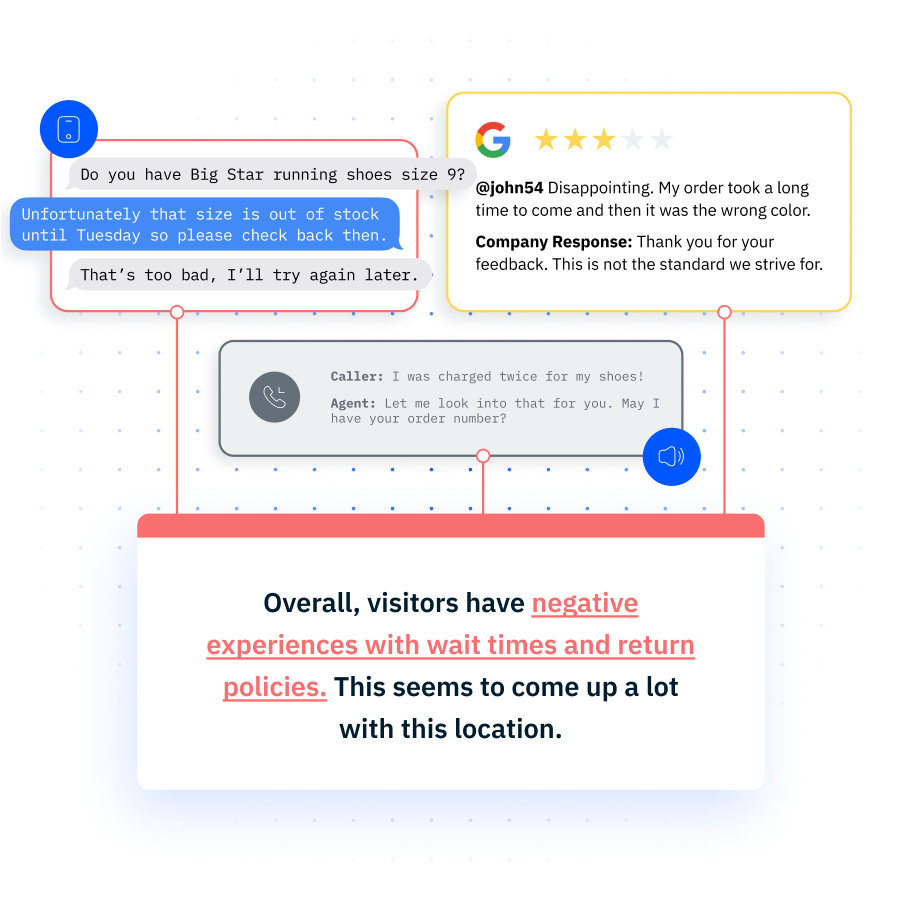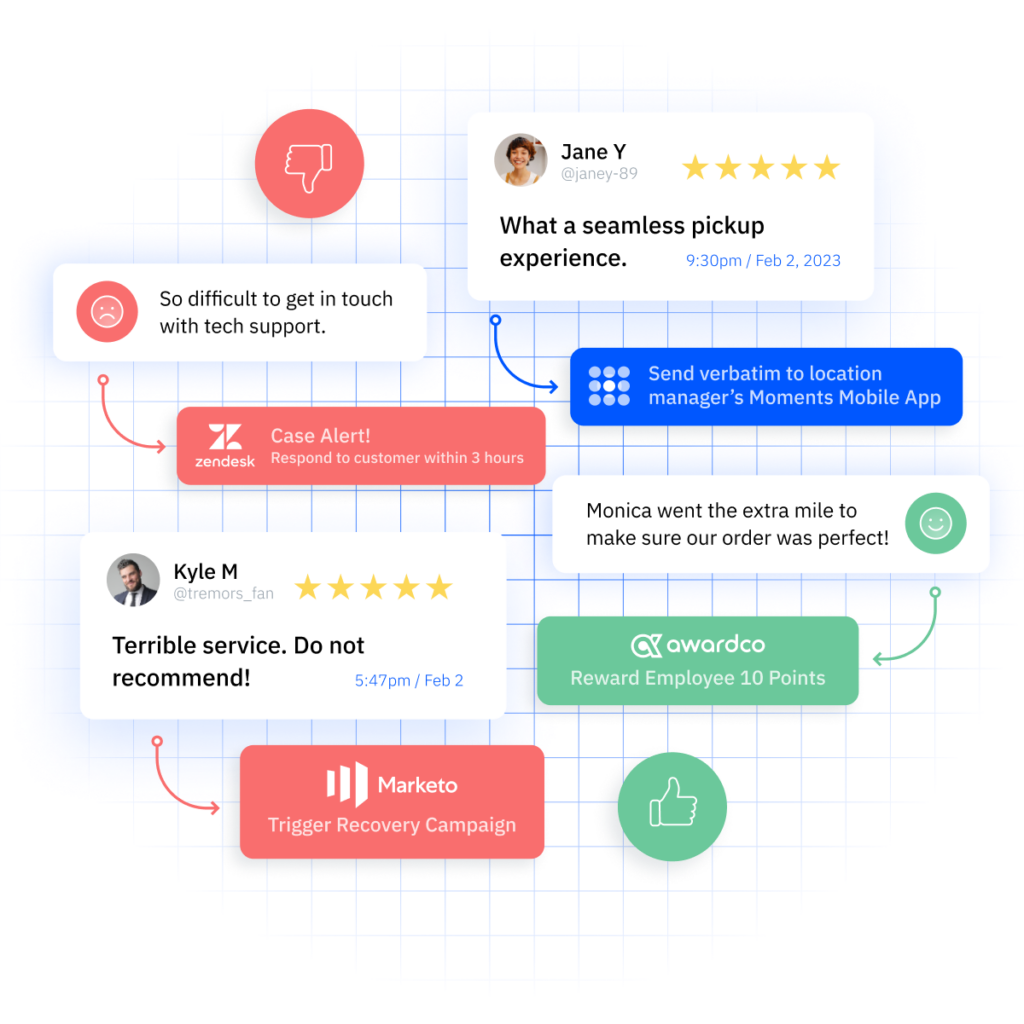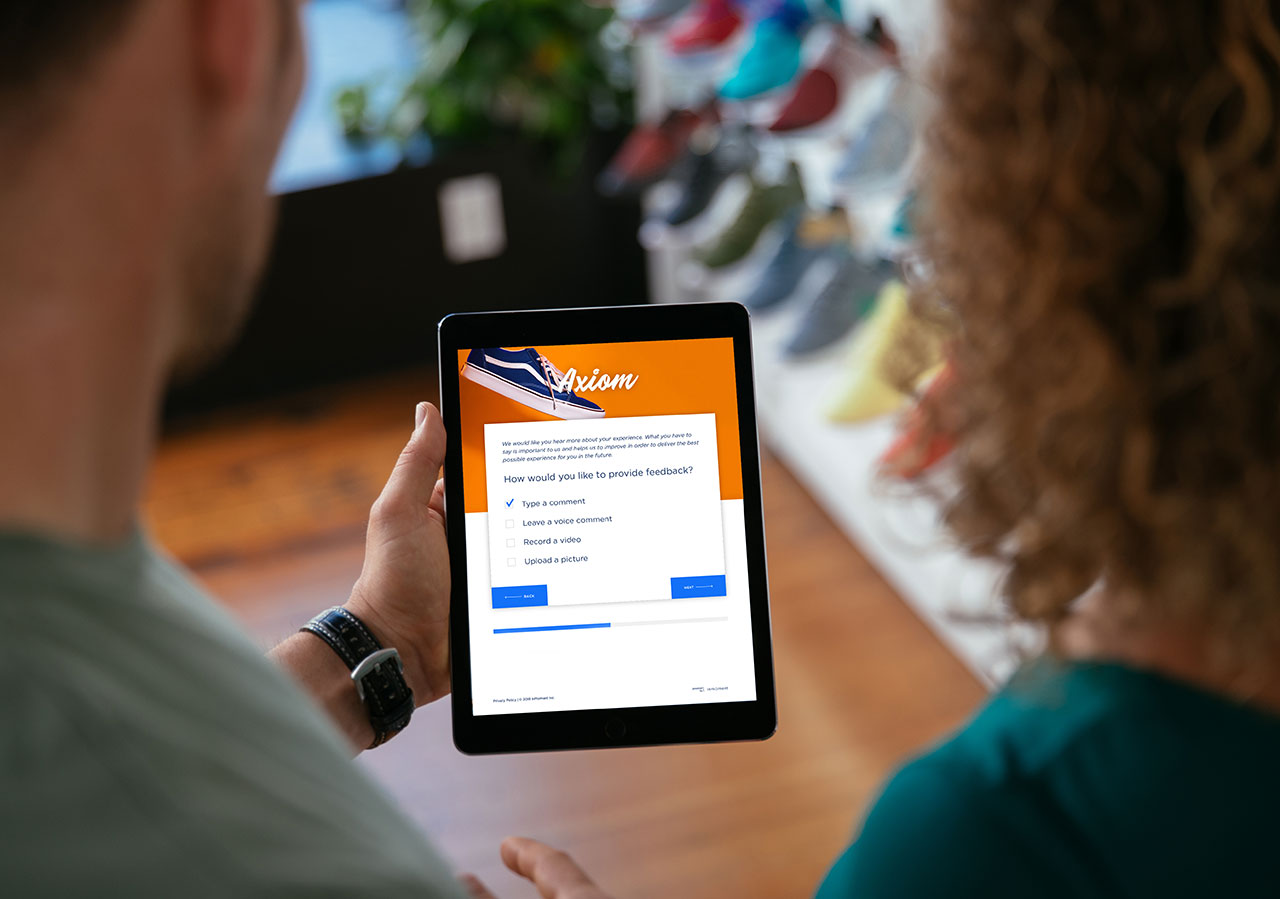Customer Loyalty: Experiences that Increase Retention
Customer loyalty is when customers consistently choose your brand over your competitors. You can encourage feelings of loyalty by consistently providing smooth, personalized, and convenient experiences.
A loyal customer is a valuable asset to your business. In fact, 64% of loyal customers are more likely to purchase frequently, and 31% are willing to spend more to stay with their brand of choice. Since customers have so many businesses competing for their attention, investing in customer loyalty can give you a major competitive edge.
What Is Customer Loyalty?
Customer loyalty defines how willing a customer is to repeat business with a company. Positive experiences compel customers to engage with you again. After all, if you’re meeting their needs and expectations, they have little reason not to trust you. Meanwhile, one negative experience can be enough to drive them to your competitors.
Loyal customers help your business by:
- Purchasing your product or service repeatedly
- Recommending your brand to friends and family
- Boosting your engagement by interacting with you online
- Providing thoughtful customer feedback to help you improve
The Importance of Customer Loyalty
Customer loyalty is crucial to business growth and sustainability.
Loyal customers tend to spend more over time and refer new clients. They also require less marketing effort to keep them engaged compared to new customers. Since a repeat customer has a 60-70% chance of converting, you’ll have to spend less on other conversion strategies.
Building customer loyalty results in higher retention, increased revenue, and positive word-of-mouth, which helps you stand out in competitive markets. To see how you could maximize your business revenue and ROI with InMoment’s voice of the customer (VoC) tools, fill out the ROI calculator below!
What Are the Different Types of Customer Loyalty?
In general, loyal customers are a by-product of excellent customer service. Positive customer experiences give rise to six distinct types of loyalty.
- Happy customers
- Price-loyal
- Convenience-loyal
- Loyal-to-freebies
- Loyal-to-loyalty program
- Truly loyal
Happy customers have never had reason to complain. They are satisfied with your offerings and customer service. Even though they often engage with you, your competitors can still sway them. For example, by selling the same product at a lower price, your competitor could convince your customer to try them out.
Price-loyal customers love your brand because of your pricing. Since affordability is key for them, they can easily leave if they find lower prices elsewhere. Retaining such a customer might seem simple, but you’ll have to compromise on your pricing model.
Convenience-loyal customers appreciate smooth and simple interactions. If you’re easy to find, contact, and buy from, they’ll become long-term consumers. Pricing isn’t a huge concern for them. So, if a competitor somehow offers an even smoother customer journey, they can be swayed even if it means they’ll have to spend more.
Freebie-loyal customers are drawn to your free offerings. For example, if your cafe offers free WiFi, you’ll attract many of these customers. They might not necessarily buy your coffee or other menu items, though. As a result, these customers don’t really contribute to your revenue streams despite being loyal to you.
Loyalty-program loyal customers appreciate your loyalty rewards more than the products themselves. When choosing between businesses, they focus on which one offers the best deals or discounts. Despite your pricing or convenience, you can retain these customers if you reward them well for their loyalty.
Truly loyal customers love your brand in every sense. They appreciate your offerings, convenience, programs, and customer service. As a result, they interact with you repeatedly and encourage others to do the same.
What Kind of Experiences Are Customers Loyal To?
Customers are loyal to experiences that save their time, make them feel valued, and satisfy their needs. The following aspects contribute to experiences that drive loyalty:
- Consistency: Customers expect reliable service and product quality whenever they interact with your business. A consistent experience builds trust and encourages repeat business.
- Quality: High-quality products and services are crucial to excellent customer experience. When customers see an unwavering commitment to quality, they are more likely to choose you over competitors every single time.
- Loyalty rewards: Offering rewards for repeat purchases incentivizes more loyalty. Discounts or points-based programs make customers feel valued and encourage long-term engagement.
- Nostalgia: Experiences that evoke positive memories can strengthen loyalty. For example, a sneaker brand releasing a new product line paying tribute to an iconic athlete would help it connect with nostalgic sports fans. Familiarity and nostalgia create a sense of connection that can strengthen customer relationships.
- Personalization: Experiences tailored to customer profiles encourage loyalty. This is because they make customers feel understood and appreciated.
- Convenience: Customers are loyal to brands that make it easy to find, purchase, and use their services. Simple and intuitive processes create a frictionless experience that appeals to everyone.
- Customer service: Prompt, friendly, and effective customer support is crucial to retaining customers. It’s normal for issues to arise, but how you resolve them can be the difference between a loyal customer and one who decides to leave!
- Brand values: Customers connect with brands that reflect their own values. Brands that show commitment to sustainability, ethics, or social causes can foster loyalty through shared principles.
What Is the Most Direct Cause of Customer Loyalty?
The most direct cause of customer loyalty is a consistently positive experience.
By providing reliable services and seamless interactions on a regular basis, you can build trust and loyalty over time. Customers have little to no reason to look elsewhere if you’re checking all the boxes for them.
Additionally, businesses that resolve issues in a swift and empathetic way show customers that they care. Responding to customer feedback within 24 to 48 hours boosts retention by 8.5%. Therefore, these actions can encourage loyalty even after a negative experience.
How Do You Build Customer Loyalty?
Building customer loyalty requires time and consistent effort. Use these tips to lay the groundwork for lasting customer loyalty and retention:
- Simplify everything for your customers.
- Meet customers where they are.
- Personalize the experience.
- Keep evolving to meet changing customer needs.
- Focus on effective communication.
- Invest in loyalty programs.
- Build a deep emotional connection.
- Build a community around your offerings.
- Express gratitude.
Simplify Everything For Your Customers.
Customers appreciate ease at every touchpoint of their journey. Simple and convenient experiences encourage repeat business because they require very little customer effort.
For example, you can include a chatbot on your website to offer instant support to customers. Instead of waiting for a human agent, they can find quick answers to some of their pressing questions. This ease of finding support will prevent frustration and encourage repeat interactions.
Meet Customers Where They Are
Another way to offer convenient experiences is to meet customers where they are. For example, if a portion of your customers are avid Instagram users, it makes sense to have an active presence there. This makes it easier for them to discover your products or reach out to you for support.
94% of customers will spend more with businesses that offer their preferred mode of communication to contact customer service. As a result, building an omnichannel customer experience will help you satisfy customers and drive revenue.
Personalize the Experience
With a growing demand for personalized services, it’s important to tailor customer experiences to individual profiles. Personalization makes customers feel understood and valued, which can lead to loyalty over time. This is where collecting and analyzing feedback can be a game-changer for you. There is no better way to understand your customers’ needs than by simply asking them!
A CX platform like InMoment simplifies this process for you. It helps you collect feedback from every possible source so that you don’t miss out on valuable data. With the award-winning InMoment AI, you can then capture analytical insights from the feedback. These insights help you better understand your customers, allowing you to personalize your services.
Keep Evolving to Meet Changing Customer Needs.
You need to change the way you think about customer loyalty. Instead of treating it as the final destination, you should view it as an ongoing journey. Since customers tend to be loyal to a few different brands at one time, there is no room for complacency.
Keep up with the times by tracking customer sentiment toward you and your competitors. See what trends are going viral and where customer preferences are leaning. If you have multiple locations across the world, it’s crucial that you don’t ignore regional trends.
You can stay relevant by adopting a customer-centric approach and tweaking offerings where necessary.
Focus on Effective Communication
Good communication builds trust and strengthens relationships. Customers who interact with a transparent and honest business are more likely to stay loyal to it.
Be clear, concise, and responsive in all interactions. Address customer concerns promptly and provide regular updates when needed. Make clear announcements in case of a major change, like a product update or change in business hours. This will help you prevent misunderstandings and build trust over time.
Responding is just half of effective communication. Listening to feedback and acting on it is just as crucial. Consistently engaging with your audience resolves issues and strengthens loyalty by making customers feel heard.
Invest in Loyalty Programs
Loyalty programs are a powerful tool for retaining customers. Customers who feel valued are more likely to return and spend more.
Offer rewards, discounts, or special perks to show appreciation for repeat business. Keep the program simple and easy to use. Exclusive deals or early access to products can also make customers feel special.
A well-structured loyalty program encourages long-term engagement. This drives continuous business and helps build stronger relationships.
Build A Deep Emotional Connection
Go beyond transactions to connect with customers on a deeper level. Forming an emotional connection is even more important if you want to elevate your marketing efforts.
For example, if you want to collaborate with a celebrity to promote your brand, your efforts will be more effective if customers are already emotionally invested. Otherwise, it will be difficult to generate significant interest.
Start by establishing trust and transparency. Regularly collect and respond to feedback to show customers you are listening. Follow up with them to create a feedback loop to further show your commitment towards them.
With the help of InMoment’s Active Listening, you can generate intelligent questions with ease that capture customer preferences and needs. This information enables you to create personalized experiences that appeal to customer emotions. As a result, you will earn emotional buy-in from customers, turning them into loyal advocates.
Build A Community Around Your Offerings.
Create spaces where your customers can connect with each other and your brand. This can happen through social media, forums, or events. Engage regularly by sharing content, hosting discussions, or offering exclusive insights.
Encourage customers to share their experiences and ideas. A community fosters a sense of belonging, making customers feel part of something bigger than themselves.
Express Gratitude
Remember that your business succeeds because of your customers. They have several options to choose from, but they decide to trust you. Show your gratitude to them to reinforce the idea that they are valuable to you.
Include thank-you notes after product purchase or delivery. You can take it one step further by sending special messages during the holidays. These actions add a personal touch, which creates stronger customer relationships.
How Do You Measure Customer Loyalty Analytics?
- Net Promoter Score (NPS)
- Customer churn rate
- Customer retention rate
- Social media engagement
- Customer Loyalty Index (CLI)
- Customer Satisfaction Score (CSAT)
Loyalty is easy to understand, but how do you quantify it? Some businesses measure loyalty by looking at how many customers they have retained. Other companies monitor social media behavior or churn rate.
A combination of these metrics can help provide a complete picture of customer loyalty to identify areas for improvement.
Net Promoter Score (NPS)
Net Promoter Score (NPS) measures how likely customers are to recommend your brand to others. A high NPS indicates strong loyalty. Meanwhile, a low score suggests room for improvement in encouraging positive feelings towards your business.
Customer Churn Rate
Customer churn rate shows the percentage of customers who have stopped doing business with you. A low rate suggests that most of your customers trust your brand enough to interact with it again.
Customer Retention Rate
Customer retention rate highlights the percentage of customers who continue doing business with you over time. This is an important metric to track if you want to gauge long-term loyalty.
Social Media Engagement
While it’s not a quantitative measure, your customers’ social media activity can indicate their loyalty towards you. For example, if they engage frequently with your social media profile and leave positive comments, they are likely satisfied with your services.
Consider using social media management software to track keywords related to your brand. It can also help you identify customers who are advocates for your business.
Customer Loyalty Index (CLI)
Customer Loyalty Index (CLI) measures the strength of customer loyalty towards your business. It combines metrics like NPS, repurchase rates, and upselling to build a comprehensive loyalty score.
Customer Satisfaction Score (CSAT)
Customer Satisfaction Score (CSAT) measures satisfaction with a product, service, or specific interaction. It typically features questions like “How satisfied are you with [product/service/interaction]?”
Satisfied customers are likely to become repeat customers. Therefore, CSAT is a useful metric for measuring overall customer loyalty.
What Should You Look For In Customer Loyalty Software?
Customer loyalty software helps simplify the process of tracking key metrics and making improvements where necessary. Here are the key features to look for when choosing the right platform:
1. Omnichannel Communication
The ability to meet customers where they are is crucial to driving loyalty. It’s a significant part of creating smooth and convenient experiences. From Instagram DMs to emails, customers expect several options to communicate and seek support. The right software should allow you to gather customer data from every possible source in one place.
The InMoment XI platform can help you provide an omnichannel customer experience to foster loyalty. Its purpose-built tools enable you to collect and connect high-quality data from multiple platforms into a unified interface. As a result, you don’t miss out on valuable customer insights.

2. Analytics and Reporting
The software you choose should let you track and analyze key metrics like NPS, churn rate, and engagement levels. This will help you make data-driven decisions to improve the customer experience across all touchpoints.
InMoment simplifies this process by letting you create a custom customer experience dashboard featuring your brand’s most impactful metrics. You can also create and share actionable reports that provide a clear picture of your customer loyalty efforts.

3. Social Media Management
Social media is a key part of customer engagement. As a result, it’s important to monitor social media activity and leverage it for brand reputation. A good CX software should take care of this by helping you create content and track customer sentiment on various platforms.
InMoment’s social media management software helps you tap into the power of social media. From content curation and scheduling to social listening features, the platform makes it possible to create targeted content and drive engagement.
4. Custom Integrations
The right customer loyalty software should also integrate with your existing CRM, POS, and other key systems. Custom integrations enable you to build a unified customer view so that you don’t miss out on anything essential.
With InMoment’s CX integrations, you can easily connect all your current systems to your CX platform. As a result, you get to make the most of the customer data available to you.

5. Automation Tools
Automated workflows are key for closing feedback loops without wasting time. For example, it’s helpful to have automated responses and alerts that enable quick customer service.
InMoment offers automated alerts based on customer behavior so that you can act quickly and recover a customer before it’s too late. If a customer has a complaint, you are notified of it right away so that you can respond and resolve it in time. Similarly, you can use its automated tools to send personalized offers or reward notifications to customers.

Inspiring Customer Loyalty Quotes to Get Buy-In
Customer loyalty efforts are successful when every member of your team believes in their value. The following quotes can help you motivate your teams to focus on loyalty-driven strategies:
- “Satisfaction is a rating. Loyalty is a brand.” – Shep Hyken
- “The goal as a company is to have customer service that is not just the best, but legendary.” – Sam Walton
- “There is a big difference between a satisfied customer and a loyal customer. Never settle for ‘satisfied’.” – Shep Hyken
- “The purpose of a business is to create a customer who creates customers.” – Shiv Singh
- “Loyal customers, they don’t just come back, they don’t simply recommend you, they insist that their friends do business with you.” – Chip Bell
Increase Customer Loyalty with InMoment
Loyal customers bring more revenue by repeating business with you and recommending you to others. Therefore, converting a satisfied customer into a loyal one can make a world of difference for your brand.
With InMoment’s customer loyalty platform, you can leverage feedback collection, sentiment analysis, and actionable insights to deliver memorable experiences. Schedule a personalized demo today to see how you can keep customers coming back!







